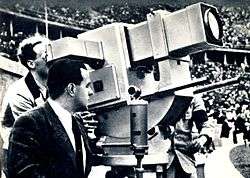180-line television system
180 lines is an early electronic television system. It was used in Germany after on March 22, 1935, using telecine transmission of film, intermediate film system, or cameras using the Nipkow disk. Simultaneously, fully electronic transmissions using cameras based on the iconoscope began on January 15, 1936 with a definition of 375 lines.

The Berlin Summer Olympic Games were televised, using both closed-circuit 375 lines fully electronic iconoscope-based cameras and 180 lines intermediate film cameras transmitting to Berlin, Hamburg, Munich, Nuremberg and Bayreuth via special Reichspost long distance cables in August 1936. In Berlin, twenty-eight public 180 lines television rooms were opened for anybody who did not own a television set. After February 1937 both 180 and 375 lines systems were replaced by a superior 441-line system.
| System | Field frequency | Active picture | Field blanking | No. of broad pulses | Broad pulse width | Line frequency | Front porch | Line sync | Back porch | Active line time | Video/syncs ratio |
|---|---|---|---|---|---|---|---|---|---|---|---|
| 180 lines | 25 Hz | 169 lines | 11 lines | 1 per field | 200 μs | 4500 Hz | 2.2 μs | 20.0 μs | 2.2 μs | 197.8 μs | 75/25 |